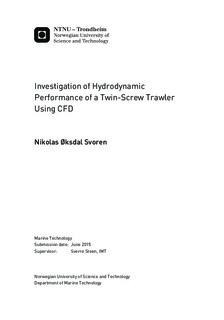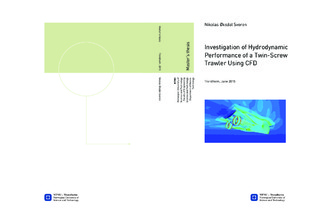| dc.description.abstract | Previously experimental methods or empirical knowledge laid the foundation for ship design. Performing a model test in a towing tank is time consuming and expensive. In addition to this, studying detailed effects in a laboratory proves to be difficult.
The exponential growth in computer power allows engineers to use computers and software to solve Navier-Stokes equations using computational fluid dynamics (CFD). This method allows the engineers to test different models, in a time and cost-efficient manner.
In this master thesis, a study of CFD codes to perform a resistance prediction on two different hull design for the trawler, Roaldnes, have been made. The first design being the current design from Seacon, Hull 1, the second being a design based on findings from project report (Svoren, 2014), Hull 2. The difference between these hulls can be found at the aft shoulder where Season s hull is designed with chines while the second design is without. Special emphasis was made on the inflow conditions for the propeller. This was done in order to compare and observe the effect of the changes made to the hull. STAR CCM+ from CD-adapco was chosen as CFD software, due to its user-friendly interface and powerful built in post processing tools.
A detailed and thorough convergence study was performed to find the optimal simulation setup. This study resulted in a mesh with approx. 2 mill cells, time step of 0.01s, and a domain which stretched 4 lwl aft and forth, 5 lwl to the side, 1.7 lwl up, and 3.5 lwl down. Due to symmetry, half of the model is simulated.
A total of eight simulations on both hulls, at trawl and transit speed, and with and without nozzle and virtual disk, were performed. Hull 1 displayed a low-pressure ridge over the sharp edge created by the chines. This lead to increased vorticities in this area compared to Hull 2. These vorticities propagated onto the propeller plane, where Hull 2 showed a slightly better wake field at trawl speed, and similar wake field at transit speed. A plot of the streamlines showed a low-velocity swirl of water on the inside of each skeg at both velocities. These were however almost gone when introducing suction from the virtual disk simulating the propeller.
Calculation of thrust reduction on Hull 2 showed an improvement of 3.75% compared to Hull 1. Full-scale calculations showed an improvement in total hull resistance of 6.7% at 4 knots, and 2.2% at 10 knots in favor of Hull 2.
Validation of results were made to known experimental data for a similar vessel, R/V Gunnerus. This investigation showed that the results obtained in this report was within an acceptable range from the reference vessel.
As CDF is a numerical tool to replicate reality, error sources, and uncertainty will always be of presence. Nevertheless, it can be used to show trends. Results obtained in this report suggests that Hull 2 might produce a more uniform inflow, and a better wake field for the propellers, than what can be seen from Hull 1. It also indicates that Hull 2 might produce lower thrust reduction, as well as an overall lower hull resistance at both trawling and transit. | |

